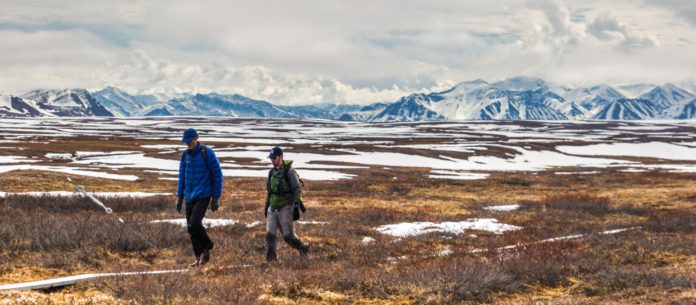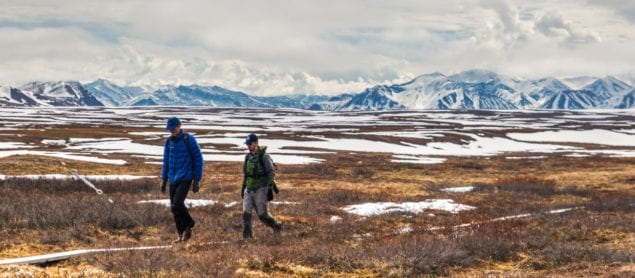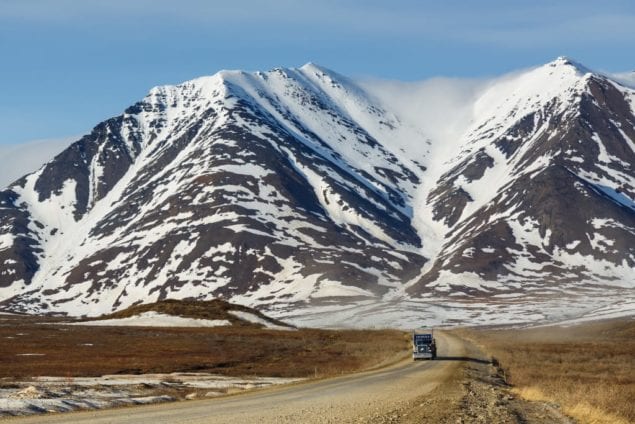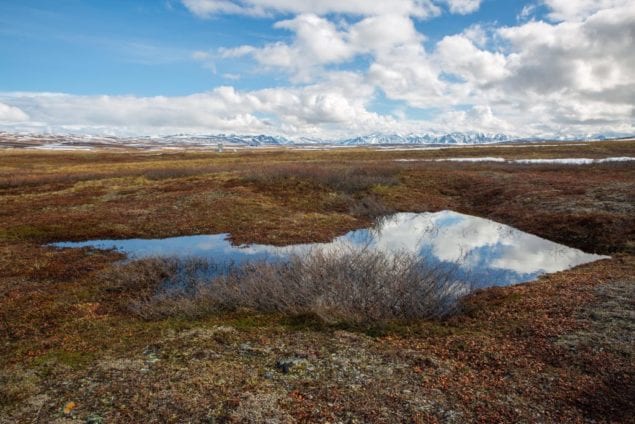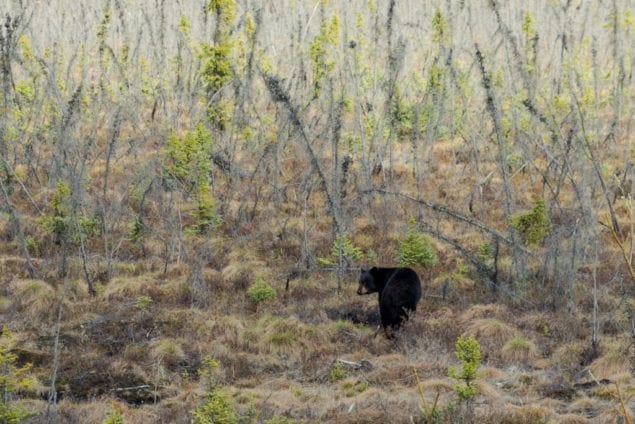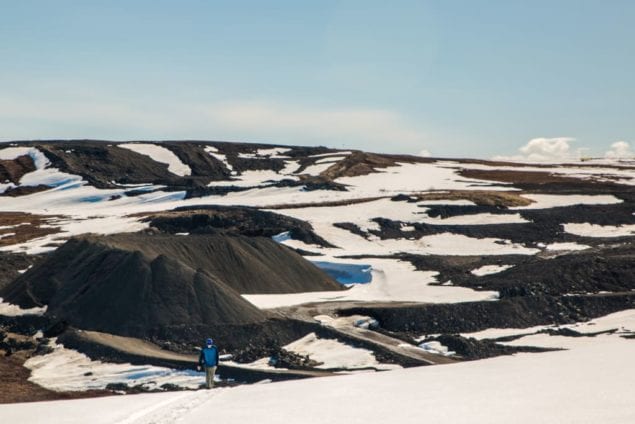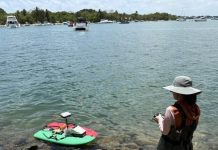FIU biologist Steve Oberbauer is back at Toolik Field Station — one of the world’s most remote research sites, located hundreds of miles above the Arctic circle. Spending time in one of the harshest, most unforgiving environments on Earth would change anyone. But, Oberbauer has changed very little. In some ways, the 64-year-old still resembles his younger self — the one who first traveled to Toolik in 1985 when he was 30. His curly hair is only slightly greyer. He’s still slender. Although he is the shortest of his two brothers, Oberbauer still towers over most people at 6 feet 5 inches tall. And he still wears a bright blue puffer jacket — an upgraded version of the one he bought more than 40 years ago for $20 that never kept him warm enough.
The Arctic, on the other hand, has changed.
“There’s always been changes. Just not this fast,” said Oberbauer, who is a botanist in FIU’s International Center for Tropical Botany at the Kampong.
The Arctic is warming at twice the rate of anywhere else on Earth. It’s in the midst of a dangerous transformation. The rules are unraveling. Timing is being thrown off track. Oberbauer has had a front seat to these changes: The tundra soil is breaking down. Permafrost is thawing at the surface and collapsing. There are more shrubs, less moss and less lichens. Plants are growing taller and flowering earlier in the season.
“What happens in the Arctic is important globally. There’s enough carbon in the tundra that if it were to thaw and that carbon release, that’s at least twice of what’s currently in the atmosphere,” Oberbauer said. “We’re better off if things stay frozen.”
But, things aren’t staying frozen. This is why every summer, before the snow melts and the plants on the tundra begin to green, Oberbauer climbs behind the wheel of “Big Red” — a Ford F-350 Super Duty truck — and sets out north from Fairbanks, Alaska.
The 10-hour journey is treacherous.
The Dalton Highway is narrow with sharp curves. It snakes up steep hills and past snow-laced mountain ranges. Unpaved in parts, the road almost disappears into the landscape, giving way to gravel that’s full of rocks and potholes. It would be safer to find another route, but there aren’t any.
So, he drives through a wild land and all its wildlife. There is a moose standing at the edge of a bog, a lone caribou searching for lichens, a Dall sheep grazing on grasses. And always there in the background — behind the animals and stretching alongside the road — is the Trans-Alaska Pipeline.
Oberbauer drives hundreds of miles. He drives until “Big Red” is no longer red, but disguised in a layer of sand and mud. He drives until he reaches Toolik Field Station, nestled in the northern foothills of Alaska’s Brooks Range. There, work is waiting for him.
Oberbauer is principal investigator of the Arctic Observatory Network — one of the few projects funded by the National Science Foundation (NSF) to conduct research on the tundra ecosystem. Every year, the FIU team, which includes Oberbauer and post-doc Jeremy May, pick up where they left off the summer before. They continue to capture the changes in the Arctic by documenting what’s happening to the tundra plant ecology. This data is extensive and long-term. It’s a legacy that will outlast them.
The Thaw
The Arctic tundra is essentially a vast frozen swamp that contains massive amounts of peat — dried, dead organic matter that contains a lot of carbon. For most of the year, this top layer stays frozen and plant growth is hindered by cold temperatures and limited nutrient availability. As temperatures rise and thawing begins, this organic matter decomposes, releasing greenhouse gases into the atmosphere. This triggers an endless cycle of warming.
“As it thaws, the environment warms up and you get more greenhouse gases. Then, it thaws even faster, which produces more greenhouse gases,” May said.
With a break from the colder temperatures, the plants are thriving. But, more green isn’t good.
Oberbauer was recently part of an international research team that found that tundra-dwelling plants are adapting to climate change by growing taller and with larger leaves. They looked at more than 55,000 plants in arctic and alpine regions, zeroing in on five traits — height, how many leaves they had and their size, how long leaves stayed on throughout the year, the rate at which they converted sunlight into energy and woodiness. Oberbauer believes the plant growth is a result of nutrients being released when the peat thaws and breaks down.
This presents an interesting dilemma: Can the increasing number of plants absorb enough carbon to counterbalance the amount being released? Only time will tell.
Off-Balance
What might be good for plants isn’t necessarily good for an entire ecosystem. Oberbauer’s research in the Arctic is also exploring how climate change impacts the timing of events in plants — when they flower, produce leaves, bear fruit and when the fruit is ripe. He believes these changes ripple outward.
Oberbauer co-authored a study led by the United States Forest Service that examined more than 10 years of data on the flowering times of more than 250 species from tundra environments. It found warming temperatures were causing plants to flower earlier than normal.
Plants and animals in cold regions take cues from weather and the day length to start their annual life cycles. Successful pollination relies on animals, including bees, beetles, birds and mosquitoes, being active at the same time plants are flowering. Shorter flowering time in the tundra could cause a mismatch if the animals are not following the same cues as plants. This could limit food availability and increase competition, impacting animals’ abilities to survive.
“If the flower is coming out two weeks earlier, but the insect that pollinates that flower isn’t coming out earlier also, then that plant isn’t going to get pollinated,” said Oberbauer. “If that plant doesn’t get pollinated, it doesn’t make fruit and so there’s no fruit for the bears.”
The Escape
Oberbauer first arrived in 1976 as a young undergraduate student from San Diego State University. Most of that first trip, he was locked away in a lab at the University of Alaska. By the end of the summer, he’d wasted away, losing so much weight he was all skin and bones. He was eventually diagnosed with Giardia, an intestinal parasite.
He almost convinced himself to never return. But, the following year, he went back. He escaped the lab and instead camped outside in a tiny, rustic field camp full of birdsong. Oberbauer helped conduct research on ecosystem models for the tundra that calculated energy, water and nutrient flower through the ecosystem.
This experience changed everything. The Arctic became a wilderness wonderland to him. He fell in love. A love that’s lasted more than four decades.
The MIST
Clouds hang low, touching the tops of Brooks Range. Snow lays in a patchwork across the ground. Oberbauer appears in the distance – that tall, thin figure in the blue puffy jacket and baseball cap. He’s a small speck in an expansive landscape, setting out to begin tracking plant progression over the summer.
Oberbauer and his team often have to hike several miles to reach the research sites. They will splash through frigid pools of melted snow. They will come across deep snow banks that swallow them up to their thighs. Using shovels, they will attempt to carve paths forward. Sometimes, the snow is piled too high and they turn back and find new routes. It is strenuous, exhausting work. Oberbauer moves with ease and determination.
When they arrive, Oberbauer and the team will walk the thin wooden planks that weave a way across the ground. This makeshift boardwalk protects the plants — because although they are hardy from surviving season after season in one of the harshest environments on earth, they are also incredibly fragile and delicate. Their duality mirrors the current state of our planet: Warming even by a few degrees can cause a catastrophic cascade of changes across the world.
The team sets a trolley-like machine called the Mobile Instrument and Sensor Platform (MIST) on a pair of steel coated wires floating four feet above the ground. It takes 20 minutes to complete the 50-meter journey across the plot. While it’s moving, it’s also gathering important data on the different plant species. The MIST is equipped with several different instruments: a thermal camera that looks at the plants temperatures, a 3D camera that measures their height and progression, as well as a camera that measures wave bands, or how the plants are absorbing and reflecting solar light — from UV to deep infrared light — which is key to understanding the overall health of plants. This data is then archived on an NSF arctic database.
These daily measurements are extremely valuable. They can tell how daily weather events have affected the plants and how they have greened up over the season. This is the best way to capture variations and understand what’s driving the changes. NASA has shown interest in Oberbauer and the team’s work with the MIST, because it’s similar to what satellites are capable of doing, but the measurements happen over longer intervals and at a larger scale.
Oberbauer and the team have been taking these daily measurements since 2011. They have amassed so much data, it is too much for one team to sift through. But they aren’t collecting this information for themselves.
“We collect more data than we could ever deal with at the moment, but it’s for people in the future. It’s for people 30 years from now, so they can look back on it as the baseline and see how things have changed,” May said.
Future decisions on how the world will deal with a changing climate depend on this type of long-term data. Without it, there is no way to gauge how quickly changes are happening.
The times, they are changing
From the tundra to the tropics, Oberbauer has spent his career studying climate change and how plants respond in these different areas. Since 1979, he’s been measuring carbon balance in the Costa Rican rainforest, almost as long as he’s been at Toolik. Wherever he goes, though, the message is the same: Things are changing. We’re edging closer to a threshold that would be detrimental to cross. The signs are undeniable across the world — fires, floods, extreme weather events. As the temperature rises, the faster sea ice melts and glaciers shrink. This water has to go somewhere and South Florida is ground zero for sea level rise.
At times, the reality of climate change depresses Oberbauer, but he remains optimistic. He knows that humans have inherent talents and ingenuity to help solve the problem of our warming world.
That’s why every summer he returns to Toolik. That’s why he keeps working to record the changes that are happening. He’d like to use the data he’s collected to create a tool to predict future changes, such as whether there will be more plant growth one year over the next.
He’d like to do the same thing with berries to forecast berry production.
He knows there aren’t many 64-year-olds doing this type of research, but that never stops him. “I love the work,” he said. “It keeps you sane.”
For as long as he can, he says he will return to his wilderness wonderland and continue tracking the changes in the Arctic. Because he knows one thing for certain: What begins there at the top of the world will ultimately end here. And here is everywhere.


